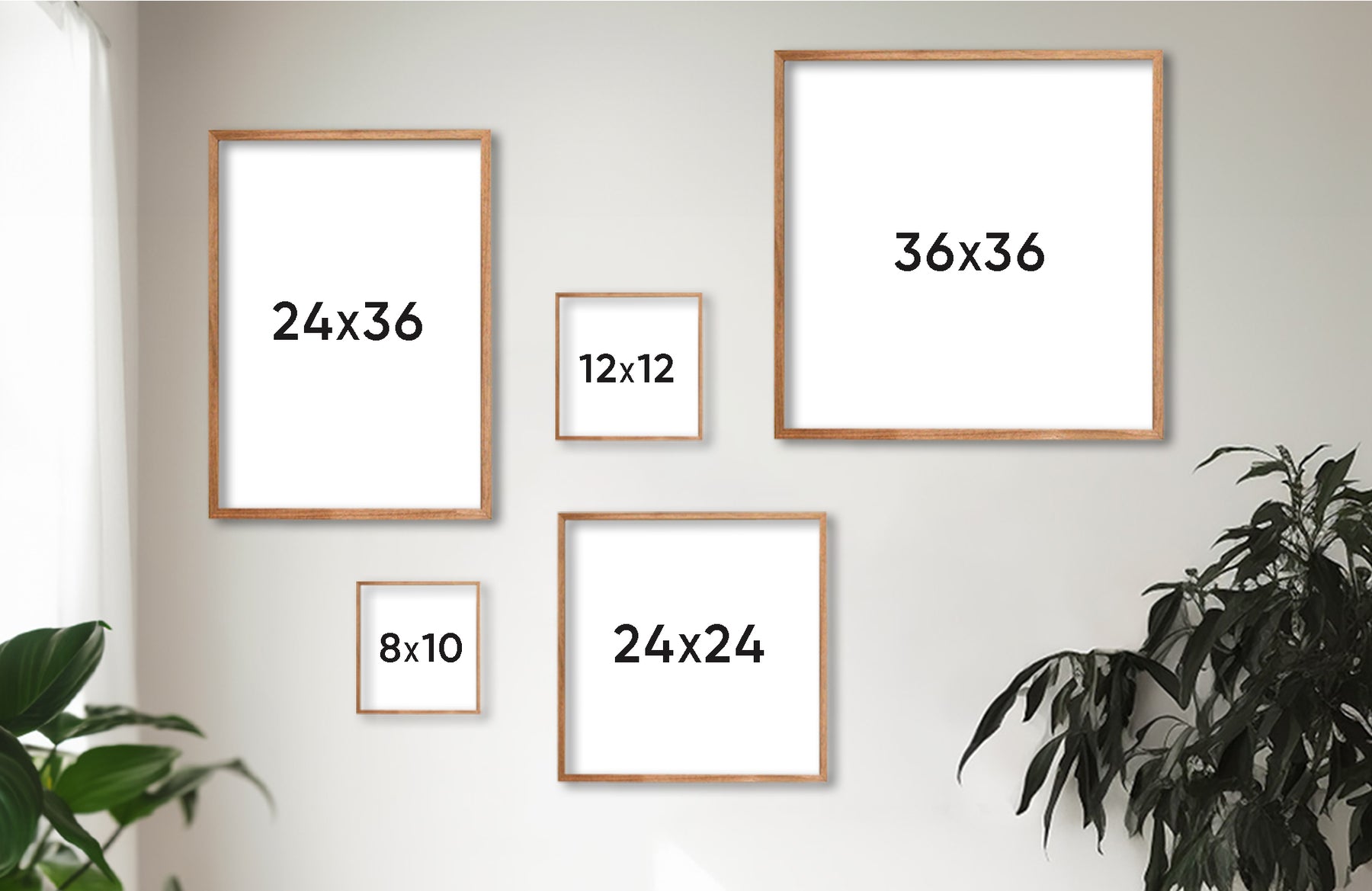Greetings, art enthusiasts! Imagine your home as a gallery, each wall an opportunity to display something extraordinary. Canvas prints allow this dream to come alive, but the difference between a good print and a stunning one lies in the resolution. Let's journey into the world of DPI (dots per inch) and discover how to make every canvas print in your home a masterpiece of clarity and color.
Sizing It Right: Canvas Dimensions That Fit Your Space
The canvas size is the skeleton of your artwork—the base upon which your image will come to life.
Square Canvases: They're trendy, fit anywhere, and provide a modern touch. Opting for a 12"x 12" can offer an understated elegance, while a 24"x24" or 36"x36" can serve as a statement piece, giving your room a focal point that's both contemporary and classic.
Rectangular Canvases: These canvases are versatile storytellers, ideal for panoramic shots, detailed artworks, and narrative pieces. The common sizes, ranging from the gallery-friendly 8"x10" to the expansive 24"x36", offer a canvas for every vision.
DPI: The Heartbeat of Your Canvas Print
When it comes to DPI, think of it as the heartbeat of your canvas print – the rhythm that keeps the image sharp and vibrant.
300 DPI: This is the sweet spot for prints that demand close inspection. It's the standard for intricate artwork that will hang at eye level, where every pixel counts.
Lower DPI? No Problem: Not every print requires such high fidelity. For instance, if your canvas will be hung high on a wall or viewed from across a room, you can comfortably opt for a lower DPI without compromising the visual experience.
Viewing Distance: The Art of Perspective
The distance from which you view a canvas can greatly affect your perception of its detail and clarity.
Up Close and Personal (0.6m/2ft): This is where high DPI shines. If viewers can get close enough to touch the canvas, you want those details to hold up under scrutiny.
At a Glance (1m/3.3ft to 2m/6.5ft): In this range, a slight reduction in DPI won't be noticeable. The artwork will still appear clear and detailed, even if the resolution isn't maxed out.
Room to Breathe (3m/10ft and beyond): Here's where the magic of perspective comes into play. Even at lower DPI values, the viewer's distance masks any loss of detail, preserving the integrity of the image.
Contextual Canvas Placement: The Impact of Environment
Consider the context in which your canvas will be displayed. If you're placing a canvas print behind a bar or another piece of furniture, the viewing distance is naturally limited by these physical barriers. In such scenarios, a lower DPI can be more than sufficient, as the average viewer won't be able to get close enough to perceive any pixelation.
From Blurry to Brilliant: Reviving Low-Resolution Photos
Not all beloved images come in high resolution, but that doesn't mean they're unsuitable for canvas prints.
Digital Enhancement: Use photo editing software to tweak and enhance. Sometimes, a few minor adjustments can bring a low-res photo up to a standard that looks great on canvas.
The Aesthetic of Blur: In some artistic contexts, a bit of blur isn't a bug; it's a feature. It can add a dreamlike quality to the image, turning a potential drawback into a stylistic choice.
Framing Choices: To Encase or Not to Encase
Frames can either make a canvas print more pronounced or serve as a subtle addition to an already vibrant piece.
Floater Frames: They add a modern layer of depth, allowing the canvas to take center stage.
Traditional Frames: These are best for adding a classic touch, creating a sense of history and permanence.
Going Big: Maximizing Impact with Large Canvas Prints
Large canvas prints are a bold choice, and with size comes the need for appropriate resolution.
Pros: They can set the theme of a room, acting as a central piece that ties everything together.
Cons: Without the right DPI, a large print can lose its luster, becoming pixelated and less impactful.
Maximizing Low-Resolution Images for Impactful Canvas Prints
Low-resolution images don't necessarily mean poor quality prints. There are several tricks to transforming these images into stunning canvas art.
The Art of Upsampling: Modern software can intelligently increase the resolution of an image, making it suitable for larger prints without visible loss of quality.
Strategic Blurring: Sometimes, applying a slight blur to a low-res image can reduce the pixelation effect and give the picture an intentional soft-focus look, which can be quite artistic and appealing on canvas.
Canvas Texture to the Rescue: The natural texture of canvas can mask some of the imperfections of lower-resolution images, lending a tactile quality that smooth paper prints can't replicate.
Printing Masterclass: Techniques for Large Digital Art
When it comes to printing large digital art, the approach needs to be strategic to ensure a high-quality output.
Printer Settings: Opt for the highest quality settings on your printer, and select the correct type of canvas in the printer's menu to ensure it uses the right amount of ink and resolution settings.
Image Interpolation: Use image editing software to interpolate the image properly when scaling up. This adds more pixels to the image in a way that maintains image quality.
Canvas Material: Choose a high-quality canvas material. A good canvas can hold more ink and present colors more vibrantly, which is essential for large prints.
The Influence of Digital Art Dimensions on Printing
Understanding the original dimensions of your digital art is crucial before you print.
Aspect Ratio Matters: Keep the aspect ratio consistent with the canvas size to avoid unwanted cropping or stretching of the image.
Resolution and Detail: If your digital art is high in detail, ensure the canvas size complements it. Don't go so large that the details become lost or so small that the intricacies can't be appreciated.
The Optimal Canvas Sizes for Different Art Genres
Different types of artwork can shine on various canvas sizes, each bringing out the best in the genre it represents.
Portraits: For portraits, especially of famous figures, a canvas size that allows the face to be life-size, like an 18"x24", can create a connection between the subject and the viewer.
Landscapes: Expansive landscape art benefits from wider canvases. A 36"x48" canvas can immerse the viewer into the scene, making them feel as if they're part of the environment.
Abstracts: Abstract art is flexible; large square canvases allow for a central focus, while longer rectangular ones can turn an abstract piece into a statement that defines a room.
16x20 Canvas: A Versatile Canvas Explored
The 16x20 canvas is a versatile choice that marries well with various art styles.
The Middle Ground: It's large enough to be a focal point but not so big that it overwhelms a space, making it suitable for both portraits and landscapes.
Gallery Wall Fit: This size works well as part of a gallery wall, allowing for ample white space around the art, which can make each piece stand out.
Resolution Through Time: A Brief History
The tale of printing resolution spans from the earliest days of artistry to the modern age. Centuries ago, the focus was on craftsmanship rather than pixel count. Yet, as digital imaging came to the fore, the ability to capture and replicate minute details changed the art world forever.
In the 1990s, 1-megapixel cameras were a marvel, yet now, our smartphones can snap images with resolutions that dwarf those early digital tools. This evolution has democratized art, allowing us to print museum-quality canvases right from our living rooms.
The Future of Resolution: A Canvas of Possibilities
As we look forward, the realm of resolution and printing continues to expand. What was once considered high-resolution is now standard, and the quest for greater detail presses on.
Final Reflections: The Convergence of Art and Innovation
In choosing the right resolution for your canvas prints, consider not just the pixels, but the story you want to tell. Whether it's a small, intimate square canvas or an expansive rectangular one, the right DPI ensures your image is presented with the clarity and vibrancy it deserves.
As we embrace the advancements in printing technology, we continue a tradition of artistry that dates back millennia. With each canvas print we hang, we participate in a legacy of human expression, bringing beauty and life to the walls we call home.
So, as you select your next canvas, consider the space, the context, and the viewing distance. Remember, the best resolution for your canvas print is one that brings your vision to life with vibrancy and clarity, creating a lasting impression and a story that unfolds with each view. Here's to the art of the past, the technology of the present, and the prints that will color our future.








Leave a comment